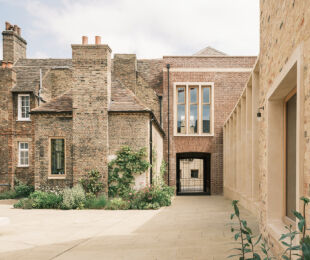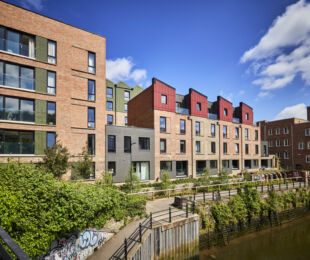
The Girls’ Hostel Block at the St. Andrews Institute of Technology and Management in Gurugram explores the intersection of education and sustainability through the lens of the vernacular. Completed in 2020, the design for the 25,000 sq.ft. Girls’ Hostel takes cues from the adjacent Boys’ Hostel Block and is articulated in brick and fair-faced concrete, with exposed structural members abutting the structure along all sides. The hostel's design empowers students with freedom of movement within an environment that prioritizes thermal comfort and functionality to become an exemplar of zero energy design.
The hostel is home to approximately 130 students, with dorm rooms spread across four levels in addition to hosting ancillary spaces like a pantry, recreational areas as well as social spaces. The ground floor comprises twelve double-occupancy rooms along with a double-height reception, pantry and indoor activity lounge where students can organize gatherings and social events.
The design faced a series of challenges from conception to execution. The primary design challenge was to create a secure hub for the girls — a campus within a campus fitting into the urban master plan that did not restrict the movement, while establishing a connection with the outdoors.
In response to the constraints, the layout has been designed to incorporate indoor and outdoor spaces that connect physically and visually at different levels to enhance interactions and social activities. Moreover, to bring in a sense of the exterior landscape, the entrance foyer and lobby are designed as outdoor spaces to face the west and are connected to the pantry so that students can enjoy their evenings outside with a spill-out into the green landscape. The students have been given the freedom to create their own space in a safe environment, without any imposed restrictions.
In terms of construction too, the staircase and the attached façade posed a design challenge. The free-standing façade was to be constructed at a thirty feet distance from the building, spanning a height of three floors keeping in mind structural integrity and earthquake resistance. This was brought to life through an extensive scaffolding and casting process.
The design seeks to reinterpret conventional standards of human comfort through introducing the idea of adaptive comfort — the principle that people experience differently and adapt, up to a certain extent, to a variety of indoor conditions, depending on their clothing, their activity and general physical condition. The building unfolds as a series of multidimensional spaces, arranged in a hierarchical order through the method of adaptive layering. Each space is conceptualized as an intimate environment that prioritizes both functionality and human comfort.
As students move from the interiors of the building into the open, they experience distinct transitions in varying thermal environments. The activity lounge on the ground flooris placed next to the landscaped court. The lounge creates an intimate environment for studying or conversation. Further, the adjacent internal landscaped court features dense plantation to reduce heat gain through evaporative cooling. From the core of the building towards the outdoor, the next transition is the second-floor terrace along the building’s west façade that attracts students in the mornings and late evenings in summers and serves as an all-day space to congregate during winters.
The design of the building is kept simple while identifying essential elements like the staircases as hubs for social interaction. The subsequent transitional zone at the heart of the building is a staircase, aesthetically incorporated into the south facade, connecting all the floors. Transitional and circulation spaces such as bridges open into lounges and pause points to create room for socializing and group study. Since the bridges create a visual connection, they enhance interaction and interconnection. They seamlessly extend into the student lounges on multiple floors creating fluid spaces. The staircase manifests as the fundamental social nucleus that is home to all activities, from large scale celebrations and events to quick informal conversations. The exterior lobby area often serves as a badminton court in the evenings and the courtyard that hosts the frequent carrom games are spaces that encourage sports and other similar games.
With limited space available along the northern façade of the hostel, a double-skin façade has been developed with the intention of creating a semi-permeable layer that would help in shading and regulating the temperature between the exterior and interior environments via a controlled airflow.
The parametric screen takes cues from the previously developed façade that spanned the adjacent boys’ hostel within the institute. The Boys’ Hostel Block’s façade was designed as an envelope in which the rotational angles of the brick were calculated in order to block diffused and direct radiation. However, it became evident that the depth of the brick when rotated, was not able to create a deep enclosure to cut off diffused radiation in the required manner. Hence, for the girls’ hostel, the exterior façade screen uses hollow pigmented concrete blocks to resemble the colour of the red brick. The blocks have been successful in addressing three concerns. Not only do they provide adequate thermal mass to absorb the heat, but with a depth of eight inches, the direct radiation has to penetrate through several layers within the block and gets reflected on different surfaces multiple times before entering the interiors reducing glare. In addition, since the block is penetrable, the air volume passing through this mass loses its heat through compression on the basis of Bernoulli’s principle. The blocks are also slightly rotated at a specific angle based on the insulation analysis with respect to solar heat gain.
The interior second skin provides a volume where the user can step out to a shaded environment such as a balcony or court. It is a space that prioritizes thermal comfort through the adaptive behaviour of the building and enables functionality. The second skin takes on the role of a breakout space such as a terrace, between the interior and exterior. It empowers students to take charge of their environment and activity as well as connect with nature while still being inside the building.
The building’s materialization in concrete and brickwork binds the different floors together. The columns are round in shape to enhance visual appearance as well as physicality. Moreover, instead of employing singular columns, the sheer mass is broken down into three columns in a tripod-like configuration to provide better structural stability as a vertical support. The pergola on the roof is designed using cement board and steel beams to achieve lightweight construction and optimum design quality.
The landscape design enriches the space by bringing the greenery inside to serve not only aesthetic but also functional purposes. Being closer to nature is scientifically proven to have a favourable impact on psychological and physiological well-being as well as create a conducive environment for interaction and this directed our landscape strategy. The edge details of the planters are designed as seaters, allowing students to sit with nature. The shaded courtyard hosts a diverse variety of plant species which require a lesser exposure to sun. The peripheral areas feature bamboo that creates a screen. Outside the building, where the ground is completely exposed to the sun, champa trees have been planted due to their large canopies to create shaded seating spaces.
The surface of the outdoor landscaped court is penetrable, facilitating ground water penetration. The wastewater such as water from the washrooms is conveyed to the sewage treatment plant and is reused for horticulture purposes.
The Girls’ Hostel building is an exemplar of sustainability through its energy efficient design. The double-skin facade acts as thermal mass, reducing the incident direct and diffused radiations by 70% on the principal façade, thus, minimizing heat gain within the habitable spaces behind the block wall. This further reduced the mechanical cooling loads by 35%, a marked increment from the ECBC (Energy Conservation Building Code) base case of public buildings.






